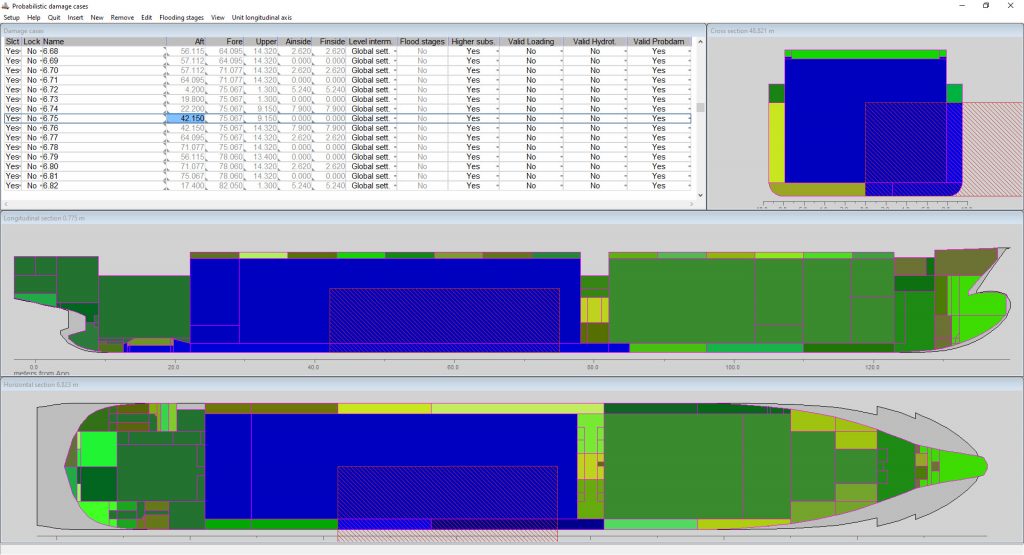PIAS module: Probdam
This is PIAS’ module for probabilistic damage stability. And not just any module for probabilistic damage stability, it is the most versatile and, actually, the best software that exists for it. Not only for its extensive set of applicable regulations:
- SOLAS 2020, for cargo vessels over 80 m as well as passenger vessels.
- SOLAS 2009, the predecessor of SOLAS 2009.
- SPS 2008, for Special Purpose Ships.
- SOLAS 1992, for cargo vessels with a length over 80 m, has been superseded by SOLAS 2009-2020.
- IMO resolution A.265, the so-called equivalent rules for passenger vessels. Has been replaced by SOLAS 2009-2020, but can still be relevant for refits of elder vessels.
- Agreement for the construction and operation of dredgers assigned reduced freeboards”, a.k.a. dr-67 and dr-68, for open hopper dredgers.
But also for the variety of powerful and user-friendly methods for the computation of the probability of damage:
- The so-called zonal method is frequently used. With this approach a ship is subdivided into so-called zones, which are approximations of the real subdivision. This approach has for the computer programmer the advantage of simplicity, because the approximated subdivision is much more regular than the real subdivision. Unfortunately, for the program user, the ship designer, these advantages turn into serious disadvantages:
- Now there are two subdivisions, one real and one approximate. And the burden of aligning the two has become the responsibility of the program user…….
- The zonal subdivision is not only approximate, it is also more coarse. So, in general the Attained Subdivision Index will be too low, for the real design of the ship.
- Because the zonal subdivision does not coincide with the real one, it cannot be derived from the vessel’s spaces and compartment layout. It requires additional user input and effort.
- A more obvious approach is the use the real compartmentation of the vessel as basis. This has been implemented in Probdam from its earliest days, and is called the compartment method. Here, the damage boundaries do not have to be specified by the user, instead they are derived from the real compartment boundaries of the ship.
- A step towards an even finer granularity is to use not the compartments but their building blocks as basis. This is called the subcompartment method.
- Tiny pieces of volume (“voxels”), which together fill the whole vessel, and which are independent from the positions of bulkheads and decks as such. The advantage of this concept is that it has no presumptions on the compartment shapes, so crisp aft, forward or inner boundaries are not required. Which fits much better to real ships and real compartment configurations, because it allows for steps, recesses , angled bulkheads and curved bulkheads in a natural way. With this method, on the background tens of thousands of damage cases are generated which might seem overwhelming. But that is all hidden, because the user only sees the real damage cases which consist of a collection of damaged real compartments. And because the basic building blocks, the ”voxels” are so elementary, the total processing time with this method is significantly less than with some other method. This method was conceived by SARC around 2006, and was then baptized numerical integration method, although with later, similar, implementations by others the term “Monte Carlo method” came into vogue.
Apart from these foundational issues, Probdam has been optimized significantly for enhanced user-friendliness. With features such as:
- Where possible, computation processes are as much as possible multithreaded. This makes that the many damage cases are distributed over up to twenty cores, with an enormous processing boost as result.
- Automatic damage case generation, and automatic determination of damage case boundaries (wherever applicable).
- Automatically optimizing VCG to achieve A=R (i.e. determine the vertical center of gravity so that the resulting Attained Subdivision Index A exactly equals the Required Subdivision Index R). A task usually done by human iteration, but automated in PIAS).


